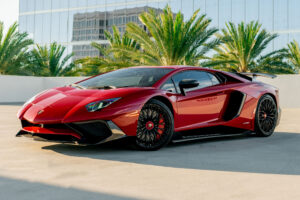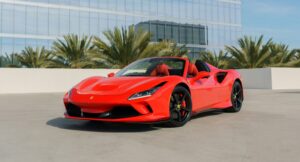Enzo Ferrari ignited a revolution in motorsports and car manufacturing in a small town in Italy. His legacy stands as a paragon of performance and luxury.
Founded in 1939 and based in Maranello, Ferrari emerged from modest beginnings to become a central figure in automotive innovation. Named after its founder, the company crafted its first car in 1940.
Post World War II, Ferrari began to produce a prestigious lineup of road cars known for their embodiment of speed, design, and luxury.
The inception of the Ferrari 125 S in 1947 marked not only the debut of a remarkable sports car but also the genesis of Ferrari’s storied racing heritage. Enzo Ferrari led the Prancing Horse brand to its first victory at the 1947 Grand Prix of Rome. The success of Ferrari in competitive racing spoke to the brand’s dedication to performance and engineering excellence.
As Ferrari grew, it became renowned for bringing race track technology to the public road, marrying high performance with striking aesthetics.
The advancements and victories in racing translated into a deep-seated passion that fueled the design and production of some of the world’s most desirable sports cars.
From the cobblestone streets of Maranello to the world’s most illustrious car showcases, Ferrari’s history is a testament to its timeless pursuit of automotive perfection.
Origins and Founding
Ferrari’s foundation is a tale of one man’s vision and the evolution of racing. It began with Enzo Ferrari’s passion for motorsport, which was catalyzed by his experiences with Alfa Romeo.
The Vision of Enzo Ferrari
Enzo Ferrari’s journey into the automotive industry started with his passion for racing. Initially a test driver and then a racer for CMN, Enzo moved to Alfa Romeo in 1920, where he found more prominence.
He quickly established himself as a skilled driver, but his true prowess lay in his ability to inspire and lead. He dreamed of creating a racing team and eventually designing and building his own cars.
In 1929, Enzo founded Scuderia Ferrari, a racing team initially operating as the de facto racing division for Alfa Romeo. Under his guidance, Scuderia Ferrari became a dominant force in motorsport, fostering considerable success and prestige.
Alfa Romeo and Early Racing
Following his tenure with Alfa Romeo as a driver, Enzo Ferrari focused on managing and developing the Scuderia. He left Alfa Romeo in 1939 to establish Auto Avio Costruzioni in Modena, which constructed machine tools and aircraft parts.
The evolving political climate and the onset of World War II required a temporary shift away from racing endeavors.
However, Auto Avio Costruzioni created its first car in 1940, the Tipo 815. Restricted by agreements not to use the Ferrari name in association with races or racing cars for four years, the Tipo 815 was not branded as a Ferrari vehicle but is recognized for its ties to the future Ferrari brand.
It marked an early foray into car making, laying the groundwork for what would become one of the most iconic names in automobile history.
After World War II, Enzo Ferrari relocated the company to Maranello and established Ferrari S.p.A. in 1947. The first car to bear the Ferrari name, the Ferrari 125 S, was produced here.
With a V12 engine, this car began Ferrari’s storied history in racing and automobile production. The 125 S achieved Ferrari’s first victory at the 1947 Grand Prix of Rome, confirming Enzo Ferrari’s belief in the racing pedigree of his automobiles. This victory set into motion a legacy of competitive racing that continues today.
Rise to Prominence
On its journey to becoming an automotive and racing icon, Ferrari achieved unprecedented success in Formula 1 and produced sports cars that would become historic benchmarks for performance and design.
Formula 1 Success
Ferrari established itself as a dominant force in Formula 1, with its cars driving to victory numerous times. The team secured its first World Championship title in 1952 and would earn a record number of championships.
Specifically, the period of dominance with Michael Schumacher at the helm is notable. From 2000 to 2004, he clinched five consecutive Driver’s Championships.
Iconic Sports Cars Development
Parallel to its F1 accomplishments, Ferrari launched a series of sports cars that solidified its reputation for excellence.
The 250 GTO, produced in the early 1960s, is revered for its racing pedigree and symbol of automotive performance and prestige.
Enzo Ferrari’s passion for creating high-performance cars also led to the birth of the Dino. This vehicle marked a new direction for the manufacturer, showcasing a mid-engine layout and initiating a lineage of cars that were more accessible yet maintained Ferrari’s high-performance standards.
Corporate Evolution and Brand Expansion
Ferrari’s corporate history is marked by strategic partnerships, particularly with Fiat, and a notable public offering that led to the global reach of its brand through ventures and licensing deals.
Fiat Partnership and Growth
1969 Ferrari entered a major phase of corporate evolution when it partnered with Fiat. Enzo Ferrari agreed to sell a 50% stake in the company to Fiat to ensure that the financially strong group could increase production and support Ferrari’s racing endeavors.
The merger played a critical role in expanding Ferrari’s production line and increasing its market presence.
Luca Cordero Di Montezemolo was appointed to lead the company in 1991, helping solidify Ferrari’s legacy in the automotive industry through increased production efficiency and retaining the brand’s uniqueness.
Going Public and Global Ventures
Ferrari’s evolution into a public company began with an Initial Public Offering (IPO) in October 2015, when Ferrari N.V. offered 10% of the company’s shares on the New York Stock Exchange.
This move was pivotal, marking Ferrari’s separation from Fiat Chrysler Automobiles. The listing valued the company at nearly $10 billion.
Post-IPO, Ferrari N.V. expanded its scope through strategic licensing deals and global ventures, leading to high-value merchandise sales.
Among the notable results was the establishment of the Ferrari World theme park in Abu Dhabi, the first dedicated to the Ferrari brand and its values.
As a public company, Ferrari has navigated the market while striving to maintain its exclusivity and high-performance ethos.
Cultural Impact and Legacy
The narrative of Ferrari extends far beyond the world of automobiles, closely interwoven with broader cultural and sporting narratives. Ferrari’s emblematic Prancing Horse and signature red color have become symbols of sophistication and performance.
In Motorsport and Beyond
Ferrari’s indelible impact on motorsport is marked by its longstanding history in Formula One racing. Since the company’s inception, Ferrari has been synonymous with the pinnacle of automotive racing, fostering a culture of excellence and competition.
The Prancing Horse, the company’s emblem on every vehicle, is a testament to its storied racing heritage and is recognized globally.
Beyond the circuit, Ferrari’s influence can be seen in its contribution to various charitable causes, such as fundraising efforts for Muscular Dystrophy.
The Ferrari Mystique and Heritage
A blend of supercars and exclusivity characterizes the allure of Ferrari. This allure extends into various aspects of pop culture and marketing.
Ferrari has managed to maintain an air of uniqueness in each model. It has also cultivated a following that sees ownership as a membership into an exclusive club.
Locations such as the Ferrari Museum preserve and celebrate Ferrari’s legacy. The museum is strategically positioned near the company’s headquarters in Maranello. Additionally, showcases in Milan bring fans closer to the brand’s distinguished history.

